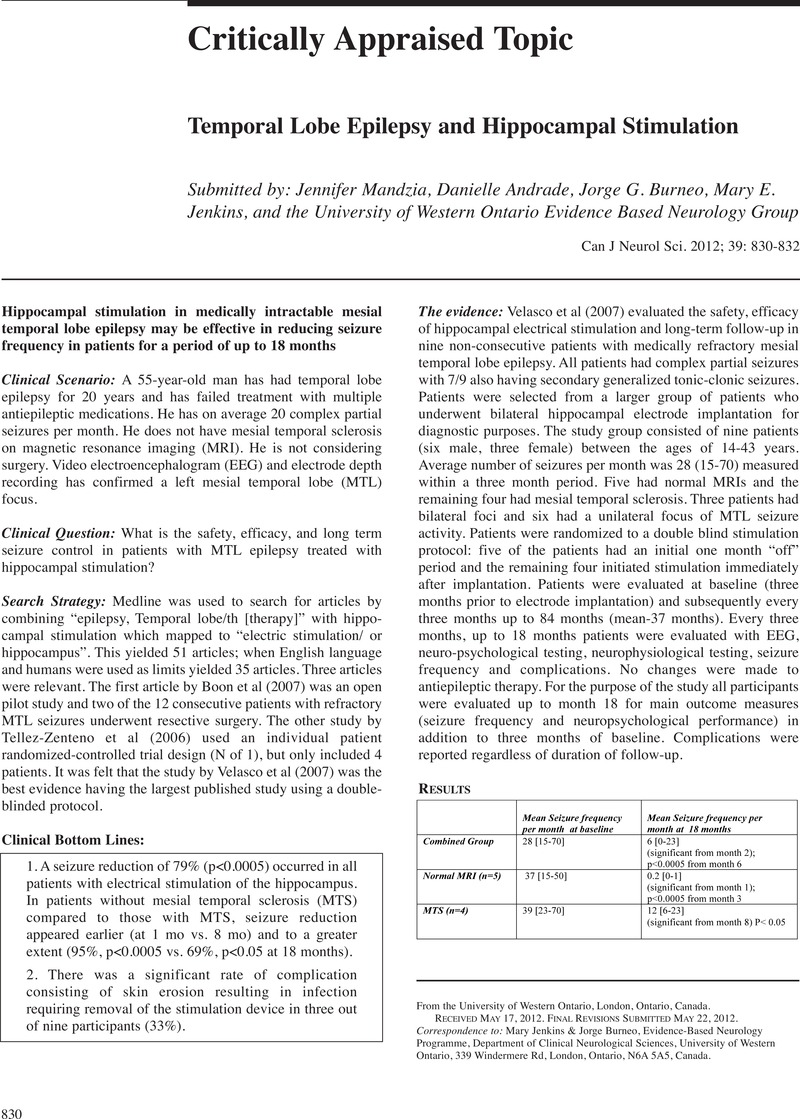No CrossRef data available.
Article contents
Temporal Lobe Epilepsy and Hippocampal Stimulation
Published online by Cambridge University Press: 02 December 2014
Abstract
An abstract is not available for this content so a preview has been provided. As you have access to this content, a full PDF is available via the ‘Save PDF’ action button.

- Type
- Other
- Information
- Copyright
- Copyright © The Canadian Journal of Neurological 2012
References
1.
Boon, P, Vonck, K, De Herdt, V, et al.
Deep brain stimulation in patients with refractory temporal lobe epilepsy. Epilepsia. 2007;48:1551–60.Google Scholar
2.
Tellez-Zenteno, JF, McLachlan, RS, Parrent, A, et al.
Hippocampal electrical stimulation in mesial temporal lobe epilepsy. Neurology. 2006;66:1490–4.Google Scholar
3.
Velasco, AL, Velasco, F, Velasco, M, Trejo, D, Castro, G, Carrillo-Ruiz, JD.
Electrical stimulation of the hippocampal epileptic foci for seizure control: a double-blind, long-term follow-up study. Epilepsia. 2007;48:1895–903.Google Scholar
4.
Tellez-Zenteno, JF, McLachlan, RS, Parrent, A, Kubu, CS, Wiebe, S.
Hippocampal electrical stimulation in mesial temporal lobe epilepsy. Neurology. 2006;66:1490–4.Google Scholar
5.
McLachlan, RS, Pigott, S, Tellez-Zenteno, JF, Wiebe, S, Parrent, A.
Bilateral hippocampal stimulation for intractable temporal lobe epilepsy: impact on seizures and memory. Epilepsia. 2010;51: 304–7.CrossRefGoogle ScholarPubMed
6.
Sheng, M, Kim, MJ.
Postsynaptic signaling and plasticity mechanisms. Science. 2002;298:776–80.Google Scholar
7.
Zucker, RS, Regehr, WG.
Short-term synaptic plasticity. Annu Rev Physiol. 2002;64:355–405.Google Scholar
8.
Liang, F, Isackson, PJ, Jones, EG.
Stimulus-dependent, reciprocal up- and downregulation of glutamic acid decarboxylase and Ca2+/calmodulin-dependent protein kinase II gene expression in rat cerebral cortex. Exp Brain Res. 1996;110:163–74.CrossRefGoogle ScholarPubMed
9.
Bertram, EH.
Why does surgery fail to cure limbic epilepsy? Seizure functional anatomy may hold the answer. Epilepsy Res. 2003;56: 93–9.CrossRefGoogle ScholarPubMed
10.
Osorio, I, Frei, MG, Sunderam, S, et al.
Automated seizure abatement in humans using electrical stimulation. Ann Neurol. 2005;57: 258–68.CrossRefGoogle ScholarPubMed
11.
Morrell, M and the RNS system Pivotal Investigators. Results of a multicentre doubleblinded randomized controlled pivotal investigation of the RNS TM system for the treatment of intractable partial epilepsy in adults. Abstract presented at the Annual Meeting of the American Epilepsy Society, 2009.Google Scholar
12.
Cuellar-Herrera, M, Velasco, M, Velasco, F, et al.
Evaluation of GABA system and cell damage in parahippocampus of patients with temporal lobe epilepsy showing antiepileptic effects after subacute electrical stimulation. Epilepsia. 2004;45:459–66.CrossRefGoogle ScholarPubMed
13.
Van Buren, JM, Wood, JH, Oakley, J, Hambrecht, F.
Preliminary evaluation of cerebellar stimulation by double-blind stimulation and biological criteria in the treatment of epilepsy. J Neurosurg. 1978;48:407–16.Google Scholar
14.
Cooper, IS, Amin, I, Gilman, S.
The effect of chronic cerebellar stimulation upon epilepsy in man. Trans Am Neurol Assoc. 1973;98:192–6.Google Scholar


